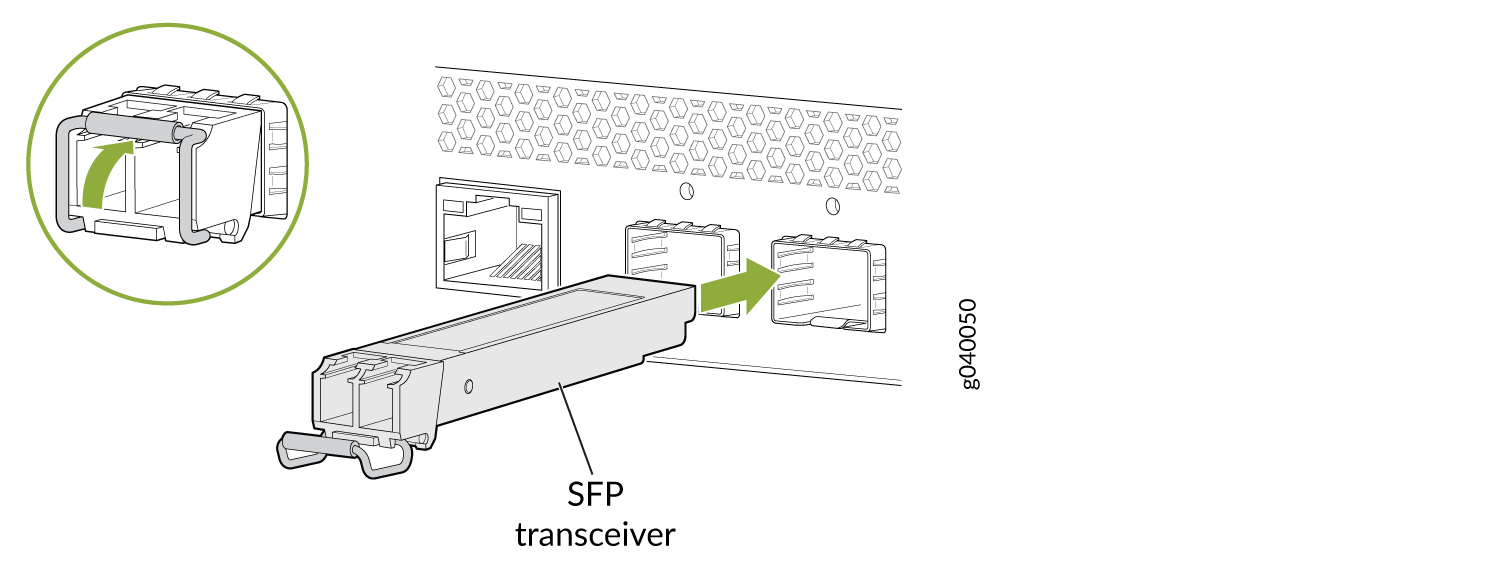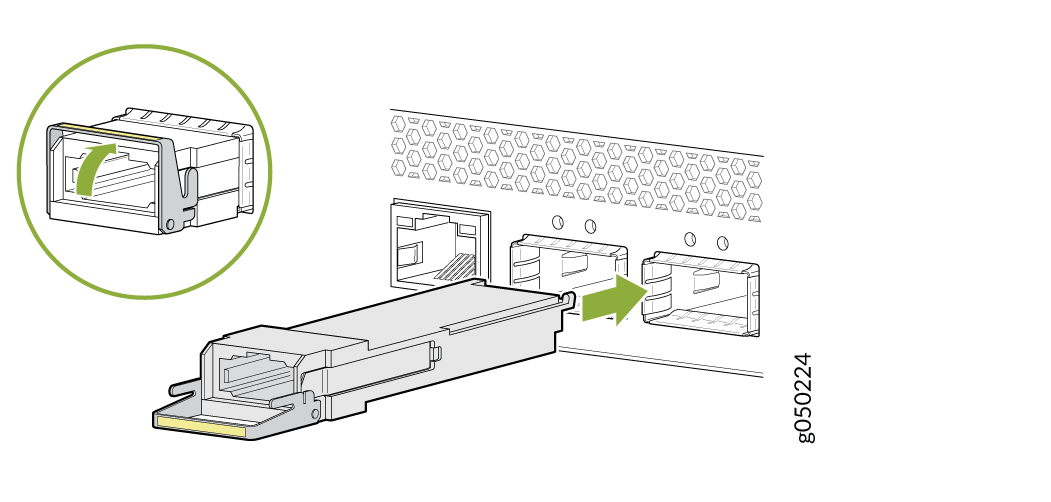- play_arrow Fast Track: Initial Installation
- play_arrow Overview
- play_arrow Site Planning, Preparation, and Specifications
- play_arrow Initial Installation and Configuration
- PTX10016 Installation Overview
- Unpack the PTX10016 Router
- Mount the PTX10016 by Using the JNP10004-RMK-4POST Rack Mount Kit
- Mount the PTX10016 by Using the EX-MOD-RMK-4POST Rack Mount Kit
- Install and Maintain the Front Door and its Components on the PTX10016 Router
- Connect the PTX10016 Router to Power
- Connect the PTX10016 Router to External Devices
- Register Products—Mandatory to Validate SLAs
- Perform the Initial Configuration for the PTX10016 Router
- play_arrow Troubleshoot Hardware
- play_arrow Contact Customer Support and Return the Chassis or Components
- play_arrow Safety and Compliance Information
- General Safety Guidelines and Warnings
- Definitions of Safety Warning Levels
- Qualified Personnel Warning
- Warning Statement for Norway and Sweden
- Fire Safety Requirements
- Installation Instructions Warning
- Chassis and Component Lifting Guidelines
- PTX10016 Chassis Lifting Guidelines
- Restricted Access Warning
- Ramp Warning
- Rack-Mounting and Cabinet-Mounting Warnings
- Grounded Equipment Warning
- Radiation from Open Port Apertures Warning
- Laser and LED Safety Guidelines and Warnings
- Maintenance and Operational Safety Guidelines and Warnings
- General Electrical Safety Guidelines and Warnings
- Action to Take After an Electrical Accident
- Prevention of Electrostatic Discharge Damage
- AC Power Electrical Safety Guidelines
- AC Power Disconnection Warning
- DC Power Electrical Safety Guidelines for the PTX10008 and PTX10016 Routers
- DC Power Copper Conductors Warning
- DC Power Disconnection Warning
- DC Power Grounding Requirements and Warning
- DC Power Wiring Sequence Warning
- DC Power Wiring Terminations Warning
- Multiple Power Supplies Disconnection Warning
- TN Power Warning
- Fire Safety Requirements
- PTX10008 and PTX10016 Agency Approvals and Compliance Statements
Maintain the PTX10016 Transceivers and Fiber-Optic Cables
The transceivers for the PTX10016 router are hot-removable and hot-insertable field-replaceable units (FRUs). You can remove and replace them without powering off the device or disrupting device functions.
To understand how to install or remove a transceiver in the PTX10016 router, read the following sections:
Install a Transceiver in the PTX10016 Router
Before you install a transceiver in a PTX10016 line card or RCB, ensure that you have taken the necessary precautions for safe handling of lasers (see Laser and LED Safety Guidelines and Warnings).
Ensure that you have a rubber safety cap available to cover the transceiver and an Electrostatic discharge (ESD) grounding strap (provided in the accessory kit).
To install a transceiver in the PTX10016 line card or RCB:
To avoid damaging the transceiver by electrostatic discharge (ESD), do not touch the connector pins at the end of the transceiver.


Remove a Transceiver from the PTX10016 Router
Before you remove a transceiver from the PTX10016 line card or RCB, ensure that you have taken the necessary precautions for safe handling of lasers (see Laser and LED Safety Guidelines and Warnings).
Ensure that you have the following parts and tools available:
An antistatic bag or an antistatic mat
Rubber safety caps to cover the transceiver and fiber-optic cable connector
Dust cover to cover the port
An Electrostatic discharge (ESD) grounding strap (provided in the accessory kit)
To remove a transceiver from the PTX10016 line card or RCB:
Connect a Fiber-Optic Cable to a Transceiver Installed in the PTX10016 Router
Before you connect a fiber-optic cable to an optical transceiver installed in the PTX10016 router, ensure that you have taken the necessary precautions for safe handling of lasers (see Laser and LED Safety Guidelines and Warnings).
Ensure that you have an Electrostatic discharge (ESD) grounding strap (provided in the accessory kit).
To connect a fiber-optic cable to an optical transceiver installed in the PTX10016 router:
Do not look directly into a fiber-optic transceiver or into the ends of fiber-optic cables. Fiber-optic transceivers and fiber-optic cables connected to transceivers emit laser light that can damage your eyes.
Do not stare into the laser beam or view it directly with optical instruments even if the interface has been disabled.
Disconnect a Fiber-Optic Cable from a Transceiver Installed in the PTX10016 Router
Before you disconnect a fiber-optic cable from an optical transceiver installed in the PTX10016 router, ensure that you have taken the necessary precautions for safe handling of lasers (see Laser and LED Safety Guidelines and Warnings).
Ensure that you have the following parts and tools available:
Rubber safety cap to cover the transceiver
Rubber safety cap to cover the fiber-optic cable connector
An Electrostatic discharge (ESD) grounding strap (provided in the accessory kit)
To disconnect a fiber-optic cable from an optical transceiver installed in the PTX10016 router:
Maintain the Fiber-Optic Cable for the PTX10016 Router
To maintain fiber-optic cables in the PTX10016 router:
When you unplug a fiber-optic cable from a transceiver, place rubber safety caps over the transceiver and on the end of the cable.
Anchor fiber-optic cable to avoid stress on the connectors. When attaching a fiber-optic cable to a transceiver, be sure to secure the fiber-optic cable so that it does not support its own weight as it hangs to the floor. Never let a fiber-optic cable hang free from the connector.
Do not bend fiber-optic cables beyond their minimum bend radius. Bending the cables beyond their minimum bend radius can damage the cables and cause problems that are difficult to diagnose.
Frequent plugging and unplugging of fiber-optic cables in and out of optical instruments can damage the instruments, which are expensive to repair. Attach a short fiber extension to the optical equipment. Any wear and tear due to frequent plugging and unplugging is then absorbed by the short fiber extension, which is easier and less expensive to replace than the instruments.
Keep fiber-optic cable connections clean. Microdeposits of oil and dust in the canal of the transceiver or cable connector can cause loss of light, reduction in signal power, and possibly intermittent problems with the optical connection.
To clean the transceiver canal, use an appropriate fiber-cleaning device such as RIFOCS Fiber Optic Adaptor Cleaning Wands (part number 946). Follow the directions in the cleaning kit you use.
After cleaning the transceiver, make sure that the connector tip of the fiber-optic cable is clean. Use only an approved alcohol-free fiber-optic cable cleaning kit such as the Cletop-S® Fiber Cleaner. Follow the directions in the cleaning kit you use.





















